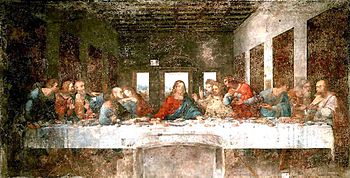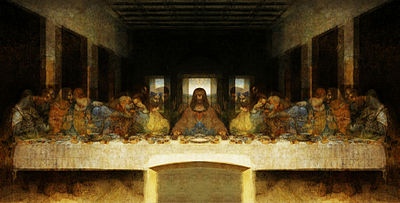
The Last Supper (Leonardo da Vinci)
Did you know...
SOS Children made this Wikipedia selection alongside other schools resources. Sponsor a child to make a real difference.
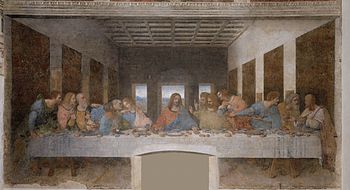 |
|
| Artist | Leonardo da Vinci |
|---|---|
| Year | 1495–1498 |
| Type | tempera on gesso, pitch and mastic |
| Dimensions | 460 cm × 880 cm (181 in × 346 in) |
| Location | Santa Maria delle Grazie, Milan |
| Coordinates: 45°28′00″N 9°10′15″E | |
The Last Supper (Italian: Il Cenacolo or L'Ultima Cena) is a late 15th century mural painting by Leonardo da Vinci in the refectory of the Convent of Santa Maria della Grazie, Milan. The work is presumed to have been commenced around 1495 and was commissioned as part of a scheme of renovations to the church and its convent buildings by Leonardo's patron Ludovico Sforza, Duke of Milan. The painting represents the scene of The Last Supper of Jesus with his disciples, as it is told in the Gospel of John, 13:21. Leonardo has depicted the consternation that occurred among the Twelve Disciples when Jesus announced that one of them would betray him.
The painting
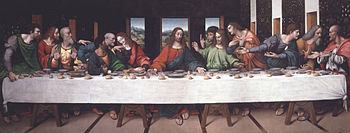
The Last Supper measures 460 cm × 880 cm (180 in × 350 in) and covers an end wall of the dining hall at the monastery of Santa Maria delle Grazie in Milan, Italy. The theme was a traditional one for refectories, although the room was not a refectory at the time that Leonardo painted it. The main church building had only recently been completed (in 1498), but was remodeled by Bramante, hired by Ludovico Sforza to build a Sforza family mausoleum. The painting was commissioned by Sforza to be the centerpiece of the mausoleum. The lunettes above the main painting, formed by the triple arched ceiling of the refectory, are painted with Sforza coats-of-arms. The opposite wall of the refectory is covered by the Crucifixion fresco by Giovanni Donato da Montorfano, to which Leonardo added figures of the Sforza family in tempera. (These figures have deteriorated in much the same way as has The Last Supper.) Leonardo began work on The Last Supper in 1495 and completed it in 1498—he did not work on the painting continuously. The beginning date is not certain, as the archives of the convent for the period have been destroyed and a document dated 1497 indicates that the painting was nearly completed at that date. One story goes that a prior from the monastery complained to Leonardo about the delay, enraging him. He wrote to the head of the monastery, explaining he had been struggling to find the perfect villainous face for Judas, and that if he could not find a face corresponding with what he had in mind, he would use the features of the prior who complained.
The Last Supper specifically portrays the reaction given by each apostle when Jesus said one of them would betray him. All twelve apostles have different reactions to the news, with various degrees of anger and shock. The apostles are identified from a manuscript (The Notebooks of Leonardo da Vinci p. 232) with their names found in the 19th century. (Before this, only Judas, Peter, John and Jesus were positively identified.) From left to right, according to the apostles' heads:
- Bartholomew, James, son of Alphaeus and Andrew form a group of three, all are surprised.
- Judas Iscariot, Peter and John form another group of three. Judas is wearing green and blue and is in shadow, looking rather withdrawn and taken aback by the sudden revelation of his plan. He is clutching a small bag, perhaps signifying the silver given to him as payment to betray Jesus, or perhaps a reference to his role within the 12 disciples as treasurer. He is also tipping over the salt shaker. This may be related to the near-Eastern expression to "betray the salt" meaning to betray one's Master. He is the only person to have his elbow on the table and his head is also horizontally the lowest of anyone in the painting. Peter looks angry and is holding a knife pointed away from Christ, perhaps foreshadowing his violent reaction in Gethsemane during Jesus' arrest. The youngest apostle, John, appears to swoon.
- Jesus.
- Apostle Thomas, James the Greater and Philip are the next group of three. Thomas is clearly upset; the raised index finger foreshadows his Incredulity of the Resurrection. James the Greater looks stunned, with his arms in the air. Meanwhile, Philip appears to be requesting some explanation.
- Matthew, Jude Thaddeus and Simon the Zealot are the final group of three. Both Jude Thaddeus and Matthew are turned toward Simon, perhaps to find out if he has any answer to their initial questions.
In common with other depictions of The Last Supper from this period, Leonardo seats the diners on one side of the table, so that none of them have their backs to the viewer. Most previous depictions excluded Judas by placing him alone on the opposite side of the table from the other eleven disciples and Jesus or placing halos around all the disciples except Judas. Leonardo instead has Judas lean back into shadow. Jesus is predicting that his betrayer will take the bread at the same time he does to Saints Thomas and James to his left, who react in horror as Jesus points with his left hand to a piece of bread before them. Distracted by the conversation between John and Peter, Judas reaches for a different piece of bread not noticing Jesus too stretching out with his right hand towards it (Matthew 26: 23). The angles and lighting draw attention to Jesus, whose head is located at the vanishing point for all perspective lines.
The painting contains several references to the number 3, which represents the Christian belief in the Holy Trinity. The Apostles are seated in groupings of three; there are three windows behind Jesus; and the shape of Jesus' figure resembles a triangle. There may have been other references that have since been lost as the painting deteriorated.
Medium
Leonardo da Vinci painted The Last Supper on a dry wall rather than on wet plaster, so it is not a true fresco. Because a fresco cannot be modified as the artist works, Leonardo instead chose to seal the stone wall with a layer of pitch, gesso and mastic, then paint onto the sealing layer with tempera. Because of the method used, the piece began to deteriorate a few years after Leonardo finished it.
Two early copies of The Last Supper are known to exist, presumed to be work by Leonardo's assistants. The copies are almost the size of the original, and have survived with a wealth of original detail still intact. One accurate copy, by Giampietrino, is in the collection of the Royal Academy of Arts, London, and the other, with some alterations to the background design, by Cesare da Sesto, is installed at the Church of St. Ambrogio in Ponte Capriasca, Switzerland.
Damage and restorations
As early as 1517, the painting was starting to flake. By 1556 — fewer than sixty years after it was finished — Leonardo's biographer Giorgio Vasari described the painting as already "ruined" and so deteriorated that the figures were unrecognizable. In 1652, a doorway was cut through the (then unrecognisable) painting, and later bricked up; this can still be seen as the irregular arch shaped structure near the centre base of the painting. It is believed, through early copies, that Jesus' feet were in a position symbolizing the forthcoming crucifixion. In 1768, a curtain was hung over the painting for the purpose of protection; it instead trapped moisture on the surface, and whenever the curtain was pulled back, it scratched the flaking paint.
A first restoration was attempted in 1726 by Michelangelo Bellotti, who filled in missing sections with oil paint then varnished the whole mural. This repair did not last well and another restoration was attempted in 1770 by Giuseppe Mazza. Mazza stripped off Bellotti's work then largely repainted the painting; he had redone all but three faces when he was halted due to public outrage. In 1796, French revolutionary anti-clerical troops used the refectory as an armory; they threw stones at the painting and climbed ladders to scratch out the Apostles' eyes. The refectory was then later used as a prison; it is not known if any of the prisoners may have damaged the painting. In 1821, Stefano Barezzi, an expert in removing whole frescoes from their walls intact, was called in to remove the painting to a safer location; he badly damaged the centre section before realizing that Leonardo's work was not a fresco. Barezzi then attempted to reattach damaged sections with glue. From 1901 to 1908, Luigi Cavenaghi first completed a careful study of the structure of the painting, then began cleaning it. In 1924, Oreste Silvestri did further cleaning, and stabilised some parts with stucco.
During World War II, on August 15, 1943, the refectory was struck by a bomb; protective sandbagging prevented the painting from being struck by bomb splinters, but it may have been damaged further by the vibration. From 1951 to 1954, another clean-and-stabilise restoration was undertaken by Mauro Pelliccioli.
Major restoration
The painting's appearance by the late 1970s had become badly deteriorated. From 1978 to 1999, Pinin Brambilla Barcilon guided a major restoration project which undertook to permanently stabilize the painting, and reverse the damage caused by dirt, pollution, and the misguided 18th and 19th century restoration attempts. Since it had proved impractical to move the painting to a more controlled environment, the refectory was instead converted to a sealed, climate controlled environment, which meant bricking up the windows. Then, detailed study was undertaken to determine the painting's original form, using scientific tests (especially infrared reflectoscopy and microscopic core-samples), and original cartoons preserved in the Royal Library at Windsor Castle. Some areas were deemed unrestorable. These were re-painted using watercolor in subdued colors intended to indicate they were not original work, while not being too distracting.
This restoration took 21 years and on 28 May 1999 the painting was returned to display, although intending visitors are required to book ahead and can only stay for 15 minutes. When it was unveiled, considerable controversy was aroused by the dramatic changes in colours, tones, and even some facial shapes. James Beck, professor of art history at Columbia University and founder of ArtWatch International, had been a particularly strong critic. Michael Daley, director of ArtWatch UK, has also complained about the restored version of the painting. He has been critical of Christ's right arm in the image which has been altered from a draped sleeve to what Daley calls "muff-like drapery".
The Last Supper in culture
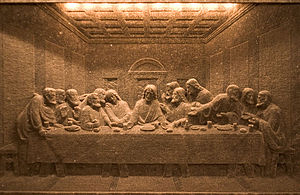
Painting, mosaic and photography
A 16th century oil on canvas copy is conserved in the abbey of Tongerlo, Antwerp, Belgium. It reveals many details that are no longer visible on the original. The Roman mosaic artist Giacomo Raffaelli made another life-sized copy (1809–1814) in the Viennese Minoritenkirche.
Modern art
In 1955, Salvador Dalí painted The Sacrament of the Last Supper, with Jesus portrayed as blonde and clean shaven, pointing upward to a spectral torso while the apostles are gathered around the table heads bowed so that none may be identified. It is reputed to be one of the most popular paintings in the collection of the National Gallery of Art in Washington, D.C.
In 1986, Andy Warhol was commissioned to produce a series of paintings based on The Last Supper that were exhibited initially in Milan. This was his last series of paintings before his death.
Sculptor Marisol Escobar was inspired by The Last Supper, rendering it as a life-sized, three-dimensional, sculptural assemblage using painted and drawn wood, plywood, brownstone, plaster and aluminium. This work, Self-Portrait Looking at The Last Supper, (1982–84) is in New York's Metropolitan Museum of Art.
In 1988, the Australian artist Susan Dorothea White painted The First Supper, replacing Leonardo's 13 similar-featured men with women from around the world, with an aboriginal woman in the position of Christ.
In 1998, modern artist Vik Muniz displayed a recreation of The Last Supper, made entirely out of Bosco Chocolate Syrup.
In 2004, Irish artist John Byrne created "Supper", a 9.3 by 2.2 metre photo screen-printed onto vitreous enamel, depicting his modern Irish take on the painting with 13 everyday Dubliners. The piece is displayed outdoors in the Millenium Walkway north of the Millennium Bridge in Dublin.
In 2011, American cartoonist Bill Holbrook published a cartoon in which the toddler Leonardo, having time-traveled to our century, needs to be fed. The solution is a fast-food place, and the scene at the eatery is laid out in a replica of The Last Supper
Speculations
The Last Supper has also been the target of much speculation by writers and historical revisionists alike, usually centered around supposed purported hidden messages or hints found within the painting.
Some have identified the person to Jesus' right (left of Jesus from the viewer's perspective), not as John the Apostle, but a woman, often purported to be Mary Magdalene. This speculation was the topic of the book The Templar Revelation (1997) by Lynn Picknett and Clive Prince, and plays a central role in Dan Brown's fiction novel The Da Vinci Code (2003).
There have also been other popular speculations about the work. It has been suggested that there is no cup in the painting, yet Jesus' left hand is pointing to the Eucharist and his right to a glass of wine. (There are several glasses on the table, but they are difficult to see owing to the work's deterioration and restorations.) This is not the glorified chalice of legend as Leonardo insisted on realistic paintings. To add realism, Leonardo copied the style of the plates, glasses, utensils and the table cloth from the Dominican friars' refectory.
Further it is claimed that if one looks above the figure of Bartholomew, a Grail-like image appears on the wall. Whether Leonardo meant this to be a representation of the Holy Grail cannot be known, since as pointed out earlier there is a glass on the table within Christ's reach. The "Grail image" has become noticed probably because it only appears when viewing the painting in small scale reproductions. Zooming in on the painting reveals a cluster of geometrical shapes, possibly intended to represent marble wall decoration, or more likely, paneling on a door. They only appear to form a golden chalice when parts are deliberately occluded.
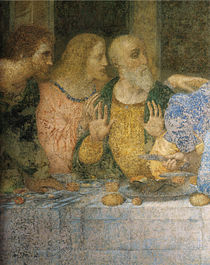 |
|
Slavisa Pesci, "an information technologist and amateur scholar", superimposed Leonardo da Vinci's version of The Last Supper with its mirror image (with both images of Jesus lined up) and claimed that the resultant picture has a Templar knight on the far left, a woman in orange holding a swaddled baby in her arms to the left of Christ, and the Holy Grail in the form of a chalice in front of Christ.
Giovanni Maria Pala, an Italian musician, has indicated that the positions of hands and loaves of bread can be interpreted as notes on a musical staff, and if read from right to left, as was characteristic of Leonardo's writing, form a musical composition.
Sabrina Sforza Galitzia, a Vatican researcher, claimed to have deciphered the "mathematical and astrological" puzzle in Leonardo's The Last Supper. She said that he foresaw the end of the world in a "universal flood" which would begin on March 21, 4006, and end on November 1 the same year. She believed that this would mark "a new start for humanity".

